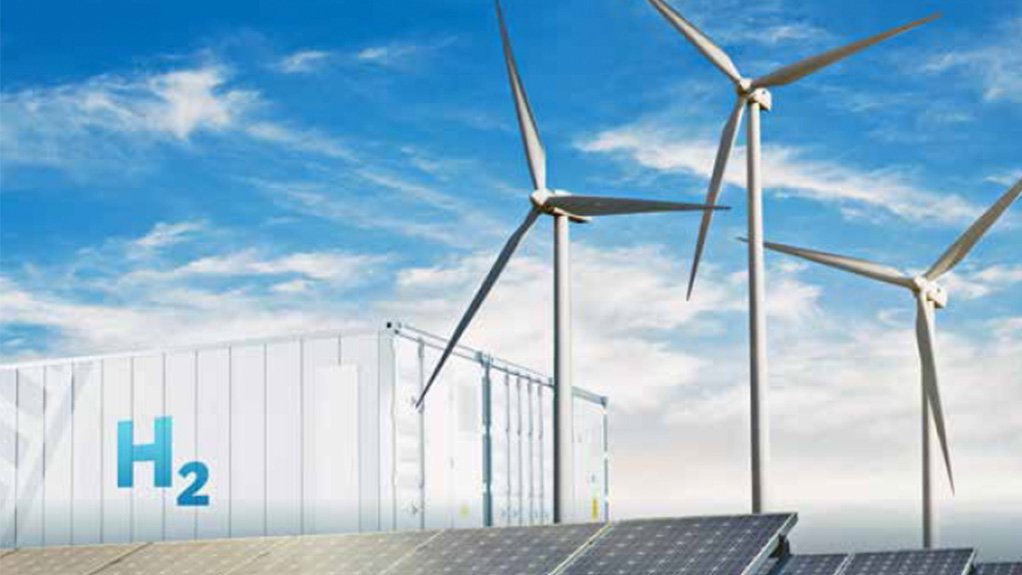Report highlights Aus' huge hydrogen potential
PERTH (miningweekly.com) – The latest annual 'State of Hydrogen' report has reinforced the notion that Australia had the foundations to become a global leader in green hydrogen.
The report illustrated local industry is advancing hydrogen as a chemical feedstock and for export to generate electricity, but pointed out that there was an urgent need to speed up priority pilot projects and hydrogen hubs to compete internationally.
The report noted that Australia’s announced pipeline of over 100 hydrogen projects was worth around A$230-billion to A$300-billion of potential investment, and represented close to 40% of all global clean hydrogen project announcements.
In 2022, more than 100 Australian green hydrogen projects such as green ammonia and green methanol manufacturing were announced. This is more than double the projects announced in 2021.
The report noted, however, that as of December 2022, only one project with a 10 MW capacity or higher had passed final investment decision from this pipeline of investment.
The report pointed out that for Australia to be a player in the global hydrogen industry, it would need to consider decisions by competing producer nations to offer increasingly more attractive, operating, cost-competitive environments could have a negative impact on decisions to invest in hydrogen projects in Australia by international firms.
The report said that the nation could also further experience challenges in supply chain security for critical items such as electrolysers and solar photovoltaic panels, as manufacturers gave preference to markets with greater scale and better prospects for growth.
“Australia risks falling behind other countries who are implementing market-based policy mechanisms and new economic incentives to propel their hydrogen industries, most notable the recent policy announcements in the US, Canada and Germany. Whilst Australia is advancing on all areas of development of the local hydrogen industry, it is important to check how that progress compares globally with progress by other nations,” the report read.
Federal Climate Change and Energy Minister Chris Bowen said the report highlighted Australia’s potential in the growing global hydrogen industry and backed up the decision of state and territory Energy and Climate Ministers to refresh Australia’s National Hydrogen Strategy.
“The world’s climate emergency is Australia’s jobs opportunity, and the government is moving quickly to make sure we seize that opportunity in green hydrogen.
“Australia’s regions have the resources, technical skills and track record with international partners to seize this opportunity and become a global hydrogen powerhouse - we need to make sure we don’t get left behind as the rest of the world moves.” Bowen said.
“By 2050, Australia’s hydrogen industry could generate A$50-billion in additional GDP and create more than 16 000 jobs in regional Australia. We have a great opportunity for entire new industries from Townsville to Gladstone, the Hunter Valley, the Pilbara, Port Bonython and Bell Bay through hydrogen hubs.
"We know our trading partners are looking to us to supply Australian hydrogen, and our industrial base requires it. We will keep our foot on the accelerator to achieve the scale of industry development necessary to compete internationally,” Bowen said.
The Minister has pointed out that the federal government is fast-tracking hydrogen investment through investing well over half a billion dollars to develop regional hydrogen hubs, inking the German–Australian Hydrogen Innovation and Technology Incubator (HyGATE) initiative, decreasing the cost of green hydrogen production and supporting cutting-edge technology in the industry.
The country has also signed a memorandum of understanding with the Netherlands, advancing cooperation on a green hydrogen supply chain, and is supporting critical investment opportunities through funding pools such as the Powering the Regions Fund, the National Reconstruction Fund, The Australian Renewable Energy Agency and the Clean Energy Finance Corporation.
Meanwhile, the Australian Petroleum Production & Exploration Association (Appea) has welcomed the report, with CEO Samantha McCulloch saying the gas sector will play a critical role in kick-starting low-emissions hydrogen.
“Natural gas combined with carbon capture, utilisation and storage (CCUS) is currently by far the most affordable pathway to low-carbon hydrogen production – meaning significantly more emissions reductions per dollar today,” she said.
“This paves the way for all low-carbon hydrogen pathways, enabling faster scale-up to support economy-wide decarbonisation.”
Under the International Energy Agency’s Net Zero by 2050 scenario, over a quarter of hydrogen in 2050 will come from natural gas utilising CCUS.
“We share the nation’s commitment to lowering emissions to get to net zero across the economy by 2050 and hydrogen will be a key tool to get there,” McCulloch said on Thursday.
“The gas sector has the expertise, infrastructure and commercial relationships necessary to make the hydrogen economy a reality and are already investors in low-carbon hydrogen development.
“As the government reviews its national hydrogen strategy, it’s critical we keep all options on the table to make sure we are rolling out hydrogen at the pace and scale required.
“Leveraging the most affordable low-carbon hydrogen pathways not only makes net zero more achievable but also minimises the impact on the costs of doing business for Australian manufacturers and industry as they align with our climate targets.”
Comments
Press Office
Announcements
What's On
Subscribe to improve your user experience...
Option 1 (equivalent of R125 a month):
Receive a weekly copy of Creamer Media's Engineering News & Mining Weekly magazine
(print copy for those in South Africa and e-magazine for those outside of South Africa)
Receive daily email newsletters
Access to full search results
Access archive of magazine back copies
Access to Projects in Progress
Access to ONE Research Report of your choice in PDF format
Option 2 (equivalent of R375 a month):
All benefits from Option 1
PLUS
Access to Creamer Media's Research Channel Africa for ALL Research Reports, in PDF format, on various industrial and mining sectors
including Electricity; Water; Energy Transition; Hydrogen; Roads, Rail and Ports; Coal; Gold; Platinum; Battery Metals; etc.
Already a subscriber?
Forgotten your password?
Receive weekly copy of Creamer Media's Engineering News & Mining Weekly magazine (print copy for those in South Africa and e-magazine for those outside of South Africa)
➕
Recieve daily email newsletters
➕
Access to full search results
➕
Access archive of magazine back copies
➕
Access to Projects in Progress
➕
Access to ONE Research Report of your choice in PDF format
RESEARCH CHANNEL AFRICA
R4500 (equivalent of R375 a month)
SUBSCRIBEAll benefits from Option 1
➕
Access to Creamer Media's Research Channel Africa for ALL Research Reports on various industrial and mining sectors, in PDF format, including on:
Electricity
➕
Water
➕
Energy Transition
➕
Hydrogen
➕
Roads, Rail and Ports
➕
Coal
➕
Gold
➕
Platinum
➕
Battery Metals
➕
etc.
Receive all benefits from Option 1 or Option 2 delivered to numerous people at your company
➕
Multiple User names and Passwords for simultaneous log-ins
➕
Intranet integration access to all in your organisation





















